Trade tensions are once again taking center stage in the U.S. political and economic landscape, raising the stakes for global markets, supply chains, and diplomatic relations. The resurgence of tariffs as a political rallying cry, signals a volatile environment for sectors ranging from manufacturing and agriculture to energy and technology. Businesses are facing increasing uncertainty as they navigate policy shifts, retaliatory measures from key partners like China, and the mounting risk of reputational fallout tied to protectionist rhetoric.
EdgeTheory’s analysis of narrative activity reveals a spike in foreign malign influence operations (FMIs) amplifying divisive messages around tariffs, trade wars, and economic nationalism. Chinese and Russian state-affiliated media have been particularly active, portraying U.S. tariff policies as damaging to domestic industries, destabilizing to allies, and hypocritical on the global stage. These narratives not only fuel domestic polarization but also aim to erode international confidence in U.S. economic leadership.
Unchecked, these influence campaigns can shape public sentiment, disrupt bipartisan policy agendas, and complicate corporate strategies dependent on global trade. Narrative Intelligence (NARINT) enables decision makers to spot these signals early—exposing the actors, themes, and geographic footprints driving narrative warfare across critical trade and supply chain domains, and enabling effective counteractive policies to maintain strategic advantage across economic and intelligence applications.
EdgeTheory employs AI aggregation systems to correlate themes, topics, influencers, and targets to map, analyze, and measure influence campaigns. Information for this briefing was taken from EdgeTheory’s brief on “Tariffs” which tracks narrative items (articles and posts) from Foreign Malign Influencers (FMI). FMI are defined as sources, accounts, or individuals promoting narratives online that align with the adversarial goals of foreign entities, primarily aligned with Russian, Chinese, or Iranian interests. By compiling thousands of articles, EdgeTheory analytic tools identified these primary influence strategies from prominent FMIs:

Screenshot of geospatial narrative origins and targets from EdgeTheory brief
These FMI strategies connect to tactical-level narratives that target vulnerable populations for influence operations, ultimately amplifying the narrative that the U.S. is at a disadvantage in international business due to its tariff policies and should be divested from. Note the financial hubs targeted in the US including Washington D.C., New York City, and Los Angeles.
Across these targets, a few major originating sources emerge, each with a distinct narrative context that poses risks to various audiences.
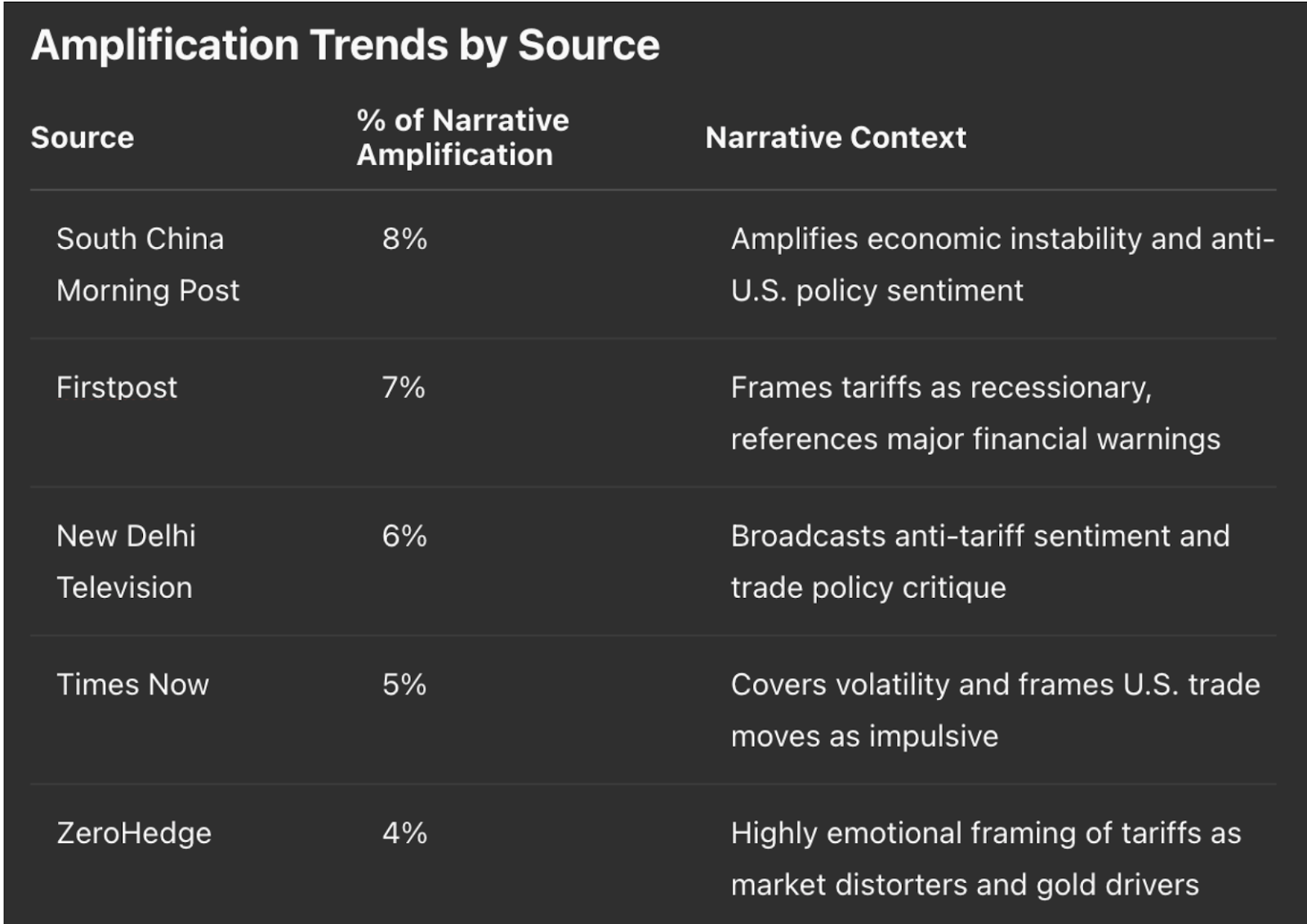
Summary of narrative strategies from most amplified sources
Asia-based media and financially motivated alternative outlets like ZeroHedge particularly amplify narrative spread, underscoring a reputational vulnerability for U.S. policy linked to global capital flows and consumer sentiment.
Narratives that portray U.S. trade policies as erratic and economically damaging create reputational headwinds for American firms in global procurement negotiations and may catalyze new regulatory barriers, delay deals, and encourage foreign suppliers to hedge by shifting contracts to competitors in "neutral" jurisdictions. In parallel, narrative framing of gold as a safe haven could signal impending investor rebalancing, which might disrupt financial access or credit availability for working capital-intensive operations.
These narratives intersect with diverse sectors, causing multilateral risks across diverse goods, ventures, and national interests:
National security risks are also impacted:
Across these applications, a few distinct FM narrative tactics emerge. Looking first to China-aligned FMI, sources use mirror imaging to attack the U.S. over tariff issues.
FMI has begun promoting AI-driven narratives framing the U.S. industrial base as both inefficient and unethical. These narratives began emerging shortly after the April 2 “Liberation Day” tariffs announced by President Trump. Assembly-line workers are portrayed in AI-generated videos as lazy and obese yet at the same time overworked while suffering from unethical and ineffective U.S. policies and a declining culture.


These attacks are an example of mirror imaging, where China reflects conditions it has identified as sub-par in its domestic workforce and amplified it as problematic in the U.S. It is China that is known for its use of sweatshops and the “tanping” movement of resistance to the modern “rat race.”
Even so, these narratives by China-aligned FMI can be effective in creating perceptions among U.S. allies that U.S. industry is not ethical nor efficiently viable for future investments, sowing doubt in further economic engagement and drawing attention to alternative partners. This strategy is critically timed to coincide with the heightened trade tensions from ongoing tariffs between the U.S. and China—by creating distrust of the US, FMI benefit as recipients of increased alternative investments.
EdgeTheory briefs identified these narratives spiked on April 2 when the “Liberation Day” tariffs were announced by President Trump. Furthermore, Asia-based sources comprise the majority of top FMI amplifiers (China-aligned underlined in red, India-aligned in blue).

Amplification timeline of top sources
Despite the high China and India-based narrative amplification, the majority of sources are Chinese, indicating the Indian narrative apparatus is focused on promoting high narrative item volume from a few well-known sources while the Chinese infosphere promotes the wide use of smaller sources.
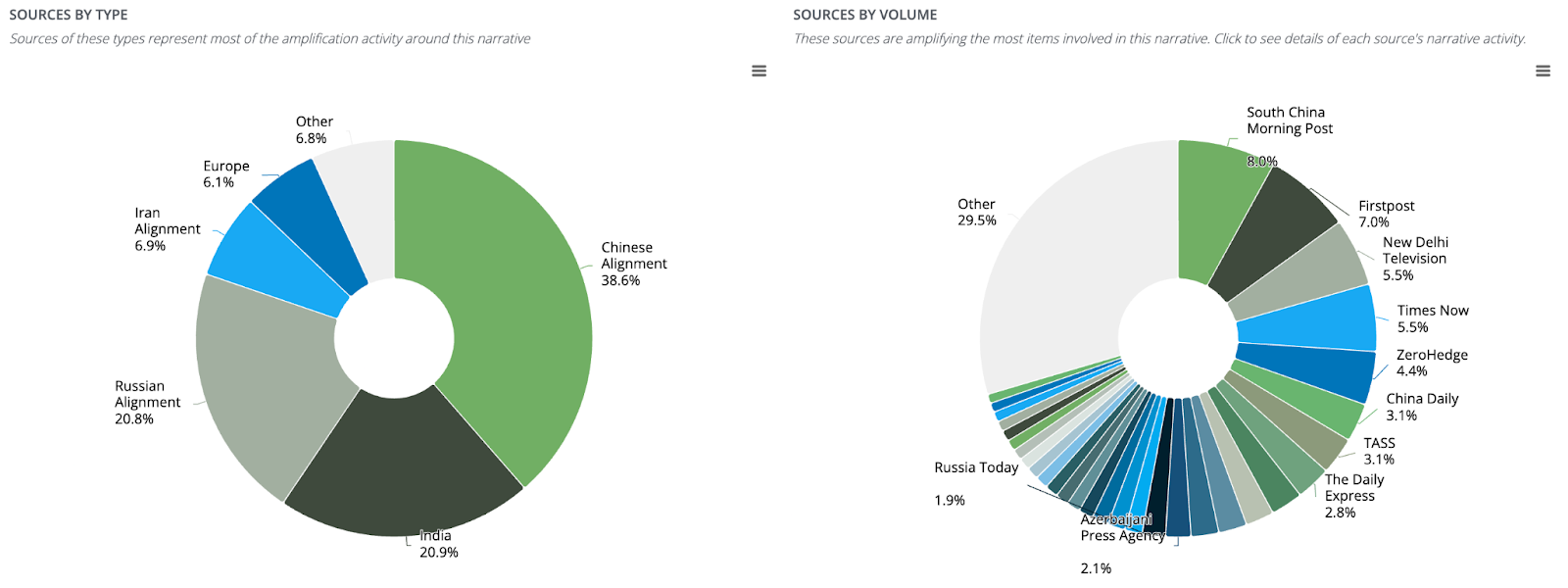
Screenshot from EdgeTheory brief
By investigating the specific narratives being pushed by these sources, EdgeTheory identified that this disparity in narrative strategies corresponds to narratives targeting different audiences. The diversified Chinese narrative amplification structure, for example, indicates a strategy to reach diverse audiences across online platforms with strategically amplified messaging, indicated below.
The South China Morning Post consistently amplifies narratives that align with broader goals typical of foreign malign influence campaigns—seeking to erode U.S. credibility, fracture alliances, and promote alternative power narratives.
These articles promoted by SCMP directly contribute to anti-US rhetoric, complicating investor relations and business risks.
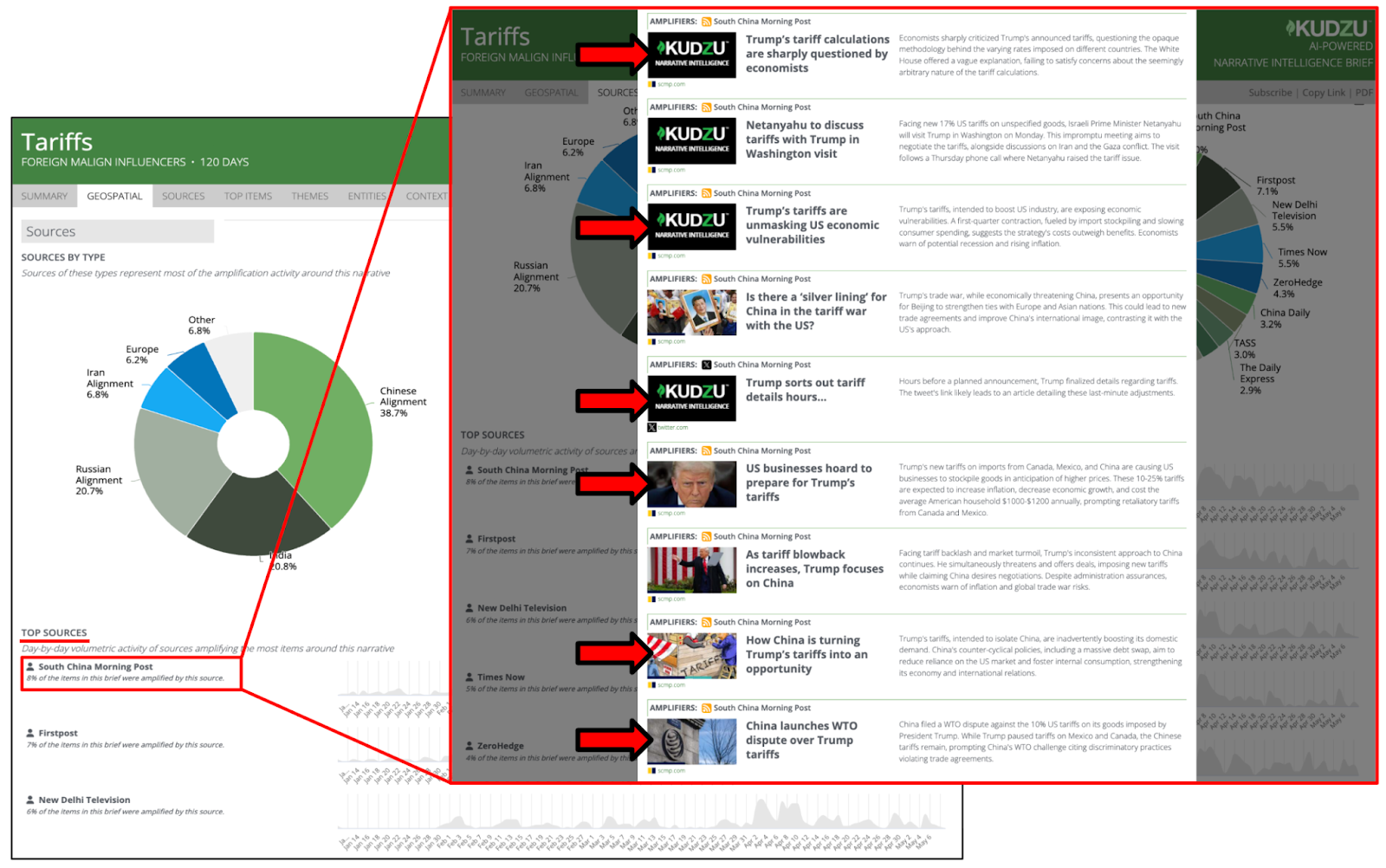
Screenshots from EdgeTheory brief indicating SCMP narrative strategies
A consistent thread across SCMP items is portraying U.S. tariff policy—particularly under Trump—as:
This narrative strategy suggests internal dysfunction, poor planning, and lack of economic foresight—contributing to domestic skepticism and weakening U.S. leadership credibility abroad.
Several articles from SCMP further highlight how other nations are retaliating, filing WTO claims, or forming strategic partnerships to counter U.S. tariffs. Examples include:
This narrative strategy projects the image of the U.S. as isolated, diplomatically belligerent, and economically provocative—encouraging international audiences to form coalitions against U.S. influence. This strategy amplifies a contrast narrative aimed at winning over neutral or wavering international stakeholders: China as the rational, rule-based actor versus a reckless U.S.
SCMP effectively boosts audience reach by promoting similar articles across internet domains, leveraging its website alongside social media like X and Facebook. EdgeTheory briefs identified the most promoted items from SCMP include all three sources, each claiming the Trump administration is not seeking collaborative efforts, as contrasted with other world leaders.

Screenshot from EdgeTheory brief comparing social media and website usage
Overall, this narrative strategy reinforces the long-term messaging goal of FMIs: weakening U.S. soft power and encouraging a multipolar world order less centered on American dominance.
Widescale FMI themes can be identified by collating and analyzing word choices and FMI targets. EdgeTheory briefs compile these themes into timelines, indicating their prominence across the past 120 days. Our brief on FMI influence regarding tariffs indicate a significant unified theme across FMI that focus on portraying tariffs as exclusively damaging policies, never recognizing the potential geopolitical leverage from import controls.
The lack of maintained volume on the issue of “Tariff negotiations and responses” indicates FMI are deliberately avoiding discussions of how tariffs might be prompting effective negotiations or international agreements. Instead, FMI attempt to undermine any public support for the Trump administration’s foreign policy strategy by framing tariffs as only punitive measures and not geopolitical bargaining chips.

Timeline of FMI tariff responses to tariffs
While the theme “Tariff negotiations and responses” was prominent in late January and early March when the Trump administration began announcing tariffs and their political purpose, little coverage included discussions of negotiations once the tariffs went into effect in April. Rather, discussions tended to focus on escalations and their disastrous effects, indicated in orange and red above.
Continued discussions of the policies themselves thus shun any recognition of their geopolitical use for leverage and focus on boosting narratives that highlight criticisms across social media. EdgeTheory briefs collate mentions of entities such as “Pricing Strategies,” “Supply Chain Vulnerabilities,” “Customer Retention," and “Tariff Policies” to measure where these narratives are originating from, what audiences are being targeted, and which items are most promoted. This screenshot from EdgeTheory briefs tracking FMI on tariffs indicates that four of the five most amplified items under the entity “Tariff Policies” are promoted through X.
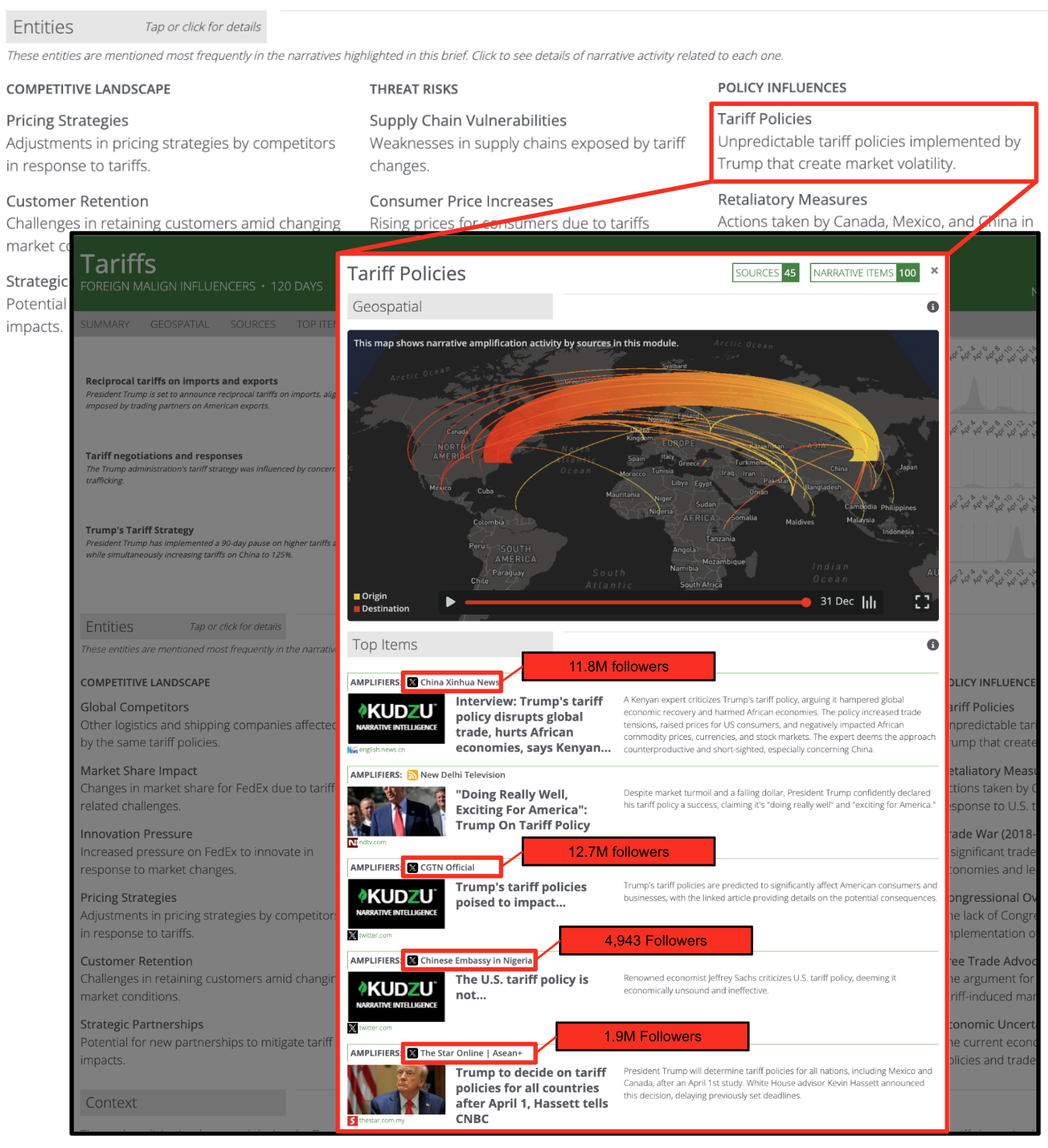
The sheer reach of these narratives can be measured by the more than 25 million followers across these accounts. Of the top 30 items, 7 were on X, 9 on websites, 9 on YouTube, and 5 on Facebook. Together, this results in more than ⅔ of top items being hosted on social media platforms.
China’s diverse amplification strategy can be seen in the use of embassy accounts to promote a unified narrative to international audiences. EdgeTheory briefs allow analysts to filter Top Items by relevance and amplification, revealing that the most relevant sources tend to be website-based (although may include social media sites including X, Facebook, and YouTube), while the most amplified items are almost exclusively through X (although some items include Telegram and Facebook).
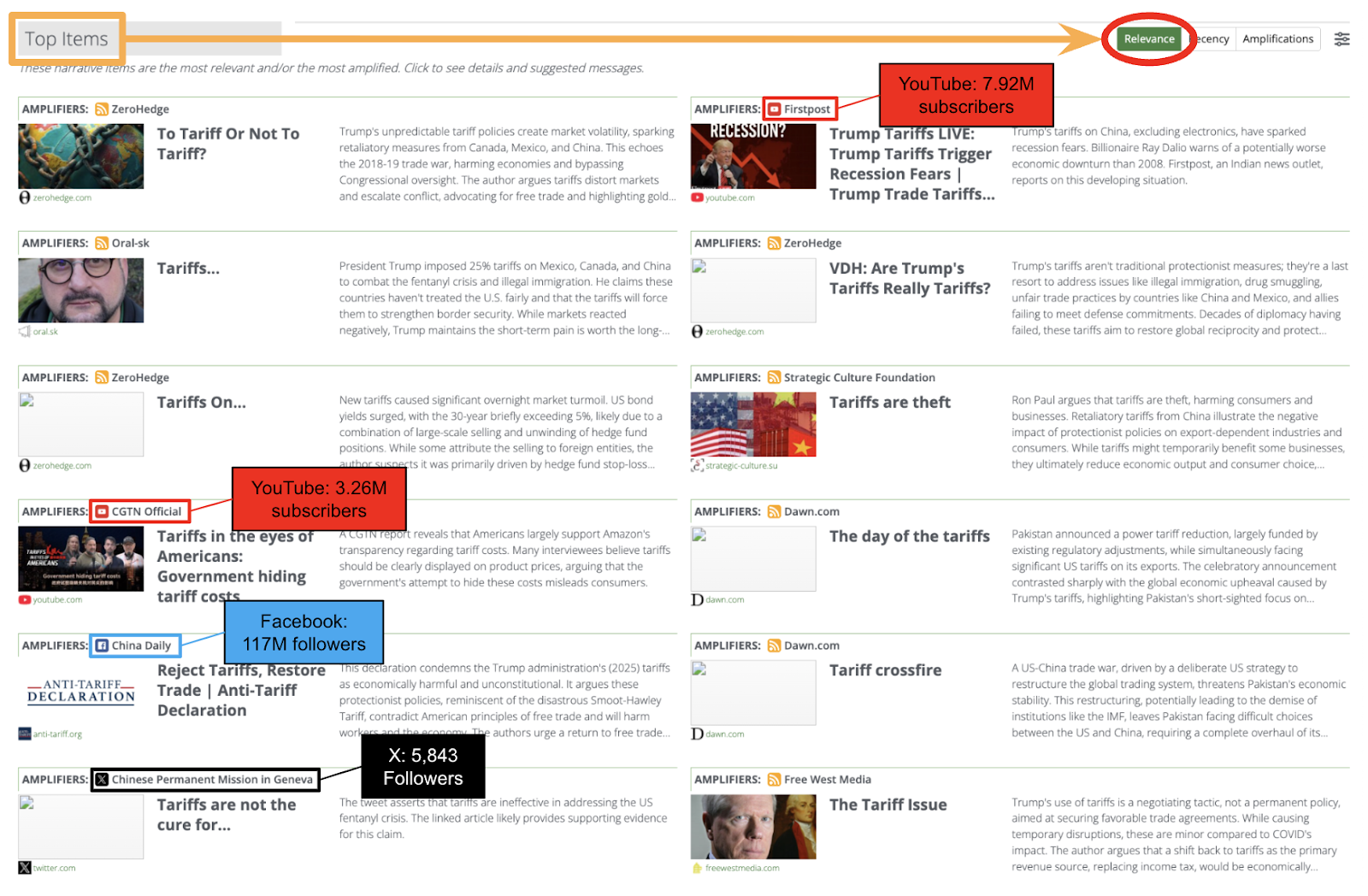
Screenshot from EdgeTheory brief

Chinese FMI are specifically using embassies to portray themselves as simply stating the “reactions of American society” and not pushing framing techniques. The Chinese embassy in Cameroon linked to mainstream outlets to claim that the US is prioritizing “selfish gains” and “pitching itself against the rest of the world.”

The source further leverages high-level US-based critics to promote anti-US economic rhetoric, even though the post is not directly related to Cameroon affairs.
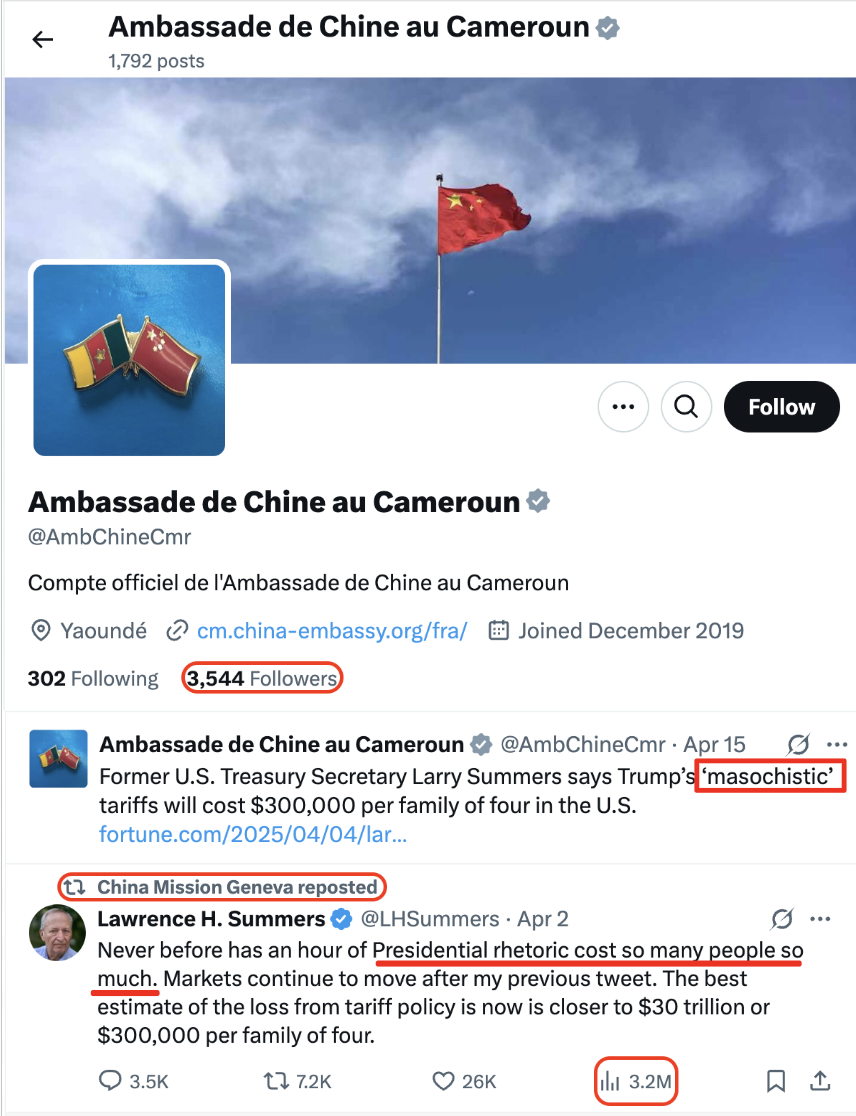
X page of Chinese Ambassador to Cameroon highlighting tariff response
FMI articles on tariffs further leverage in-country sources to undermine attempts by US policymakers to improve tariff policies. The recent trade deal between the U.S. and UK, for example, is being attacked by FMI across various internet domains, each portraying the deal not as an alleviation of the effects of Trump’s tariffs, but as an indication of underhanded political posturing.

US-UK Trade Deal Comparisons via EdgeTheory brief
It is notable that while the top source for tariffs in general are aligned with China while sources promoting criticisms of the U.S.-UK trade deal tend to be aligned with Russia. A strong US-UK trade alliance could pose a united economic front against adversaries like Russia. Undermining that unity allows Russia to push alternative trade partnerships (e.g., BRICS or China-Russia-Europe arrangements) while Western democracies appear disorganized or self-interested.
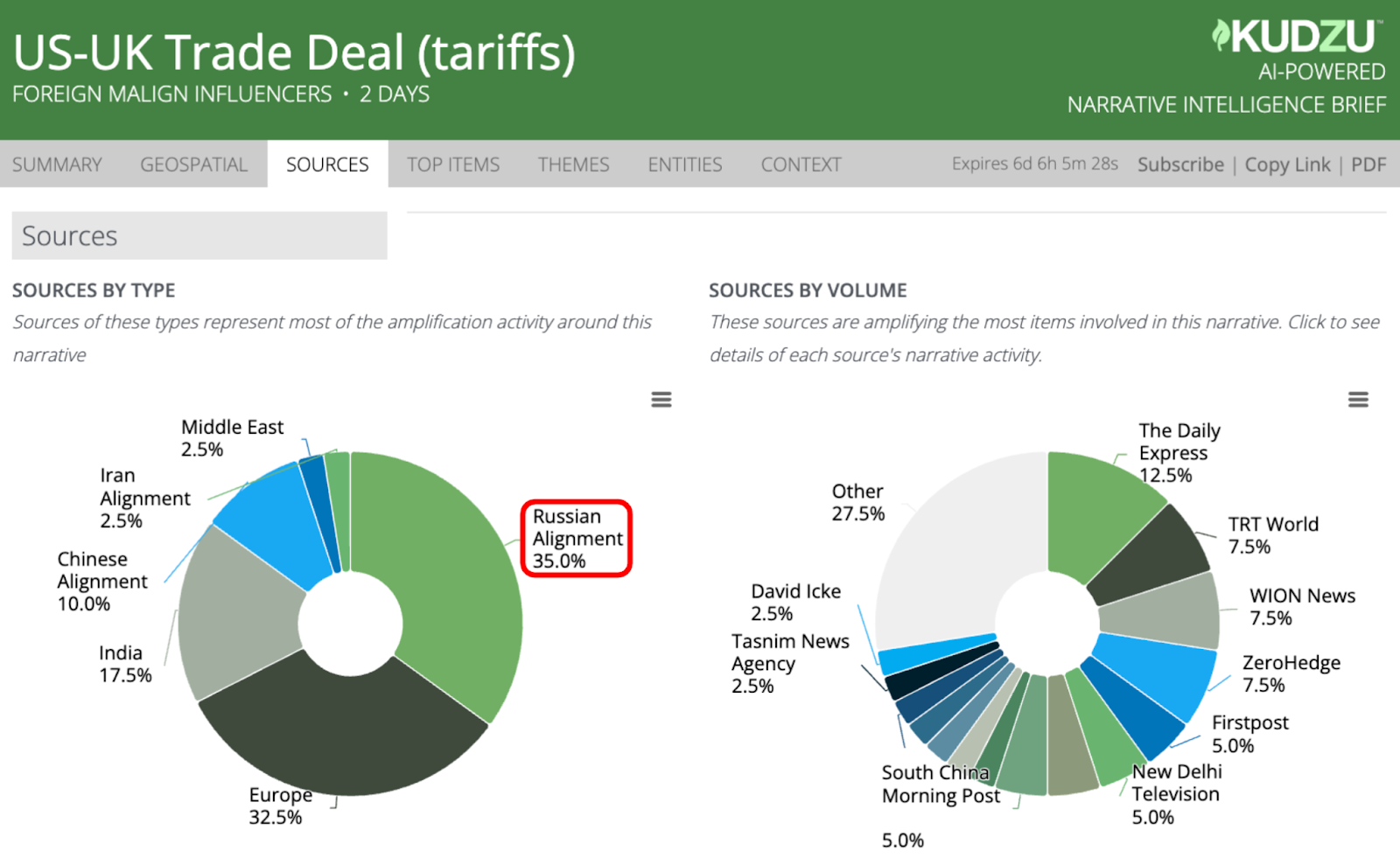
Screenshot from EdgeTheory brief
Furthermore, promoting a story where the U.S. exploits even its closest allies (like the UK) allows Russian media to cast Moscow as a more principled or reliable partner for non-aligned nations. This boosts Russia's appeal in regions where it competes for influence, such as Africa, Latin America, and Southeast Asia.
Coordinated amplification of narratives portraying U.S. tariffs as destabilizing suggests growing risk of trade retaliation from key markets. This could translate into new barriers, inspections, or penalties targeting American-origin goods under the guise of "restoring trade balance."
Recommended Monitoring Focus: